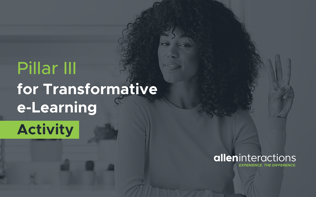Blog
Pillar III for Transformative e-Learning Instructional Design: Activity
by Ethan Edwards, chief instructional strategist | @ethanaedwards


E-Learning Design's Lost Focus on the Learner
By Ethan Edwards | April 01, 2014 | Custom Learning | 0 Comments
by Ethan Edwards, chief instructional strategist | @ethanaedwards

E-learning enjoys the odd distinction of continuously being viewed as “new” even though it has been around for quite some time. Indeed, I am by no means a pioneer in the field, and I designed and built my first lesson way back in 1982.
E-learning likely maintains this identity because technology evolves at such a fast pace that it always seems like there are as many people just starting out in the industry as there are experienced practitioners.
The result of this endless “newness” is that the conversation surrounding the field is focused more on how to get started than on how to improve e-learning. Focusing on how to get started almost always seems to center on what the designer should do—and buy. Typical questions are:
- What tool should I buy?

- What LMS should I engage?
- How do I incorporate video into my work?
- Are there graphic and animation tools I should use?
- How do I create a useful storyboard?
You get the idea. More important, I hope you noticed something in common with each of those questions: “I.” But the “I” is the designer; the learner is nowhere in the picture.
Now, I’m not saying those issues aren’t important; they are necessary matters that must be grappled with. However, answering those questions alone is not sufficient for creating effective e-learning experiences.
Instead, e-learning professionals need to start their design process focused on the learner and the experiences that are necessary to elicit desired changes in performance. This is hard because, as designers, we often are separated from the target learners.
Even our language gets in the way; “the learner” seems so remote. Let’s make it personal and say: “You.”
With that mindset, start the design process by asking questions with the learner in mind:
- Why should You care about this?
- What do You need to be able to do?
- What goal or challenge will create and hold Your interest?
- What kind of feedback will help You do better?
We need to focus a lot more on what matters to the learner at the time of instruction than on what we are doing in our roles as e-learning designers and developers. You can make a great learner-centric idea workable with a crude PowerPoint presentation, but building media and connectivity around a content-centric idea will never result in effective training.
I know this message goes a bit against the mainstream messaging from software companies, LMS suppliers, and even some established instructional design traditions, but focusing on the learner and interactivity really is at the heart of every successful e-learning solution I’ve encountered.
If you want to explore these ideas further, I suggest two things:
- Download a white paper and on-demand webinar on Creating e-Learning That Makes a Difference, which lays out a framework for design of interactivity.
- Attend ASTD’s E-Learning Instructional Design Certificate program to learn about these ideas in even more detail.

About the Author: Ethan Edwards
Ethan Edwards draws from more than 30 years of industry experience as an elearning instructional designer and developer. He is responsible for the delivery of the internal and external training and communications that reflect Allen Interactions’ unique perspective on creating Meaningful, Memorable, and Motivational learning solutions backed by the best instructional design and latest technologies.
Comments
Would you like to leave a comment?
Related Blog Posts

By: Ethan Edwards | Mar, 2021
Category: Custom Learning

Blog
Pillar II for Transformative e-Learning Instructional Design: Challenge
by Ethan Edwards, chief instructional strategist | @ethanaedwards
By: Ethan Edwards | Feb, 2021
Category: Custom Learning

Blog
Pillar IV for Transformative e-Learning Instructional Design: Feedback
by Ethan Edwards, chief instructional strategist | @ethanaedwards
By: Ethan Edwards | Mar, 2021
Category: Custom Learning


